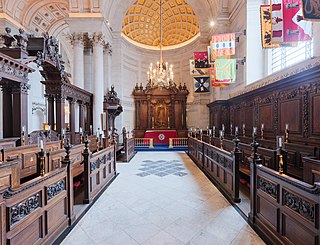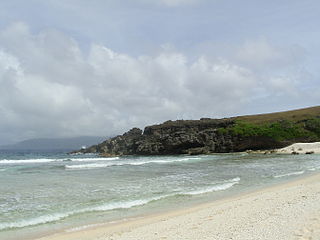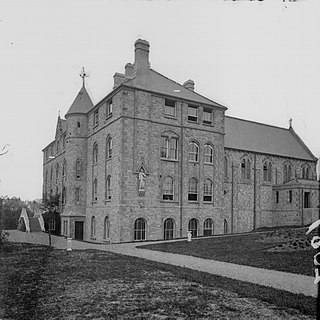
Batanes is an archipelagic province in the Philippines situated in the Cagayan Valley region. It is the northernmost province in the country, and also the smallest, both in population and land area. Its capital is Basco located on the island of Batan.

The Baroque Churches of the Philippines are a collection of four Spanish Colonial-era baroque churches in the Philippines, which were included in UNESCO's World Heritage List in 1993. The churches are also considered as national cultural treasures of the country.

The Taal Basilica, canonically known as the Minor Basilica of Saint Martin of Tours, is a Minor Basilica in the town of Taal, Batangas in the Philippines, within the Archdiocese of Lipa. It is considered to be the largest church in the Philippines and in Asia, standing 88.6 metres (291 ft) long and 48 metres (157 ft) wide. St. Martin of Tours is the patron saint of Taal, whose fiesta is celebrated every November 11.

The Minor Basilica of Saint Michael the Archangel , commonly known as the Tayabas Basilica, is a Roman Catholic basilica located in Tayabas, Quezon, Philippines under the Roman Catholic Diocese of Lucena. Its titular is Saint Michael the Archangel, whose feast is celebrated annually on September 29.

The Santa Monica Parish Church, commonly known as the Minalin Church, is a Baroque church, located in poblacion area of San Nicolas in Minalin, Pampanga, Philippines. The church, built during the Spanish era, was declared a National Cultural Treasure by the National Commission for Culture and the Arts and the National Museum of the Philippines on August 27, 2011, one of 37 churches in the country bestowed that honor.

The Church of Our Lady of the Assumption(Nuestra Señora de la Asuncion), commonly known as the Santa Maria Church is the parish church of Santa Maria in Ilocos Sur province, Philippines. The church was designated as a UNESCO World Heritage Site on December 11, 1993 as part of the Baroque Churches of the Philippines, a collection of four Baroque Spanish-era churches.

San Vicente Ferrer Church, also known as Sabtang Church, is a Roman Catholic church located near Sabtang Port in Sabtang, Batanes, Philippines. Originally a small chapel in 1785 when the Sabtang mission first opened by the Dominicans, the church underwent few modifications until 1984. A short distance to the right of the church's façade stands a pedestal with a stone statue of Saint Vincent Ferrer, the patron saint of the parish and of the municipality.
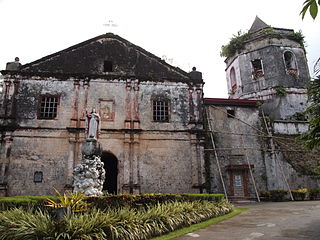
Maribojoc Church, also known as Santa Cruz Parish Church or Holy Cross Parish Church, was a Roman Catholic Church in the municipality of Maribojoc, Bohol, Philippines, under the Roman Catholic Diocese of Tagbilaran. The parish was first established by the Jesuits in 1767 or 1768 with Father Juan Soriano, SJ as its first parish priest. The Augustinian Recollects later administered the community until 1898.

La Purisima Concepcion de la Virgen Maria Parish Church, commonly known as Baclayon Church, is a Roman Catholic Church in the municipality of Baclayon, Bohol, Philippines within the jurisdiction of the Roman Catholic Diocese of Tagbilaran. Baclayon was founded by the Jesuit priest Juan de Torres and Gabriel Sánchez in 1596, and became the oldest Christian settlement in Bohol. It was elevated as a parish in 1717 and the present coral stone church was completed in 1737. The Augustinian Recollects succeeded the Jesuits in 1768 and heavily renovated the church since then.

The San Pedro Apostol Parish Church, commonly known as Loboc Church, is a Roman Catholic church in the municipality of Loboc, Bohol, Philippines, within the jurisdiction of the Roman Catholic Diocese of Tagbilaran.

The Nuestra Señora de la Luz Parish Church, commonly known as Loon Church, was a Roman Catholic Church in the municipality of Loon, Bohol, Philippines, under the Roman Catholic Diocese of Tagbilaran. The parish was established by the Jesuits in 1753. Father Jose Garcia commissioned Domingo de Escondrillas to design the stone church which was built from 1855 to 1864.
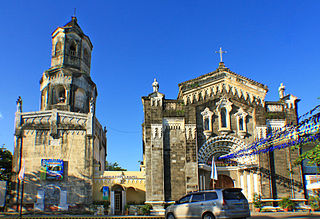
The Our Lady of Assumption Parish Church, commonly known as the Bulakan Church, is a 19th-century Neo-Byzantine-Romanesque stone church located at Brgy. San Jose, in the Municipality of Bulakan, Bulacan province, Philippines. It is one of the parishes of the Roman Catholic Diocese of Malolos under the Vicariate of the Immaculate Conception. The church was declared Marked Historical Structure of the Philippines in 2007 by the National Historical Institute, the precursor of the National Historical Commission of the Philippines. A historical marker bearing a brief history of the church was installed by the commission.
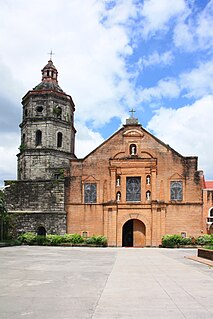
The San Agustin parish church, also known as the Lubao church, is a 17th-century Neo-classic, Spanish stone and brick church located at Brgy. San Nicolas I, Lubao, Pampanga, Philippines. In 1952, a historical marker bearing a brief history of the structure was installed on the facade of the church by the Historical Committee of the Philippines, precursor of the National Historical Commission of the Philippines. In 2013, the church has been declared by the National Museum of the Philippines as an Important Cultural Property.

The Immaculate Conception parish church, also known as the Guagua Church, is a 17th-century Baroque church located at Brgy. Plaza Burgos, Guagua, Pampanga, Philippines. In 1982, a historical marker bearing the brief history of the church was installed on the facade by the church by the National Historical Committee, precursor of the National Historical Commission of the Philippines. Today, the church is under the care of the Immaculate Conception parish of the Roman Catholic Archdiocese of San Fernando.
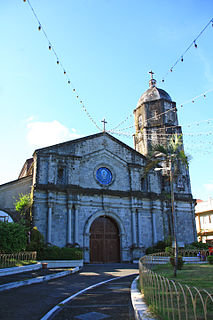
The Santa Catalina de Alejandria parish church, also known as the Porac church, is a 19th-century Baroque church located at Barangay Poblacion, Porac, Pampanga, Philippines. The parish church is currently under the ecclesiastical province of the Roman Catholic Archdiocese of San Fernando.

The San Jose Obrero Parish Church, also known as the Floridablanca church, is a 19th-century Neo-Gothic church located at Barangay Poblacion, Floridablanca, Pampanga, Philippines. The parish church, under the aegis of Saint Nicholas of Tolentine, is currently under the Roman Catholic Archdiocese of San Fernando.
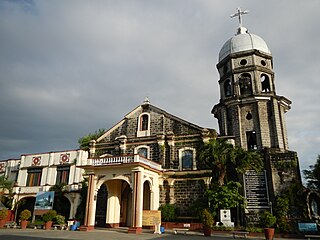
The San Andres Apostol Parish Church, commonly referred to as Candaba Church, is a 17th-century, Baroque church located at Barangay Pescadores, Candaba, Pampanga, Philippines. The parish church, dedicated to Saint Andrew the Apostle, is under the Roman Catholic Archdiocese of San Fernando.

The San Andres Apostol Parish Church, popularly known as Masinloc Church, is a 19th-century Baroque church located at Brgy. South Poblacion, Masinloc, Zambales, Philippines. The parish church, dedicated to Saint Andrew the Apostle, is under the jurisdiction of the Roman Catholic Diocese of Iba. The church structure, a standout among Spanish-era churches in the Central Luzon region for having been built with coral stone instead of adobe stone, was declared a National Cultural Treasure by the National Museum of the Philippines along with 25 other Spanish-era churches in 2001.

Aman Dangat, also known as "Kenan", was a powerful Mangpus of the town of Malakdang in the island of Sabtang in Batanes, Philippines who had led a revolt against the Spaniards from 1785 to 1791.






